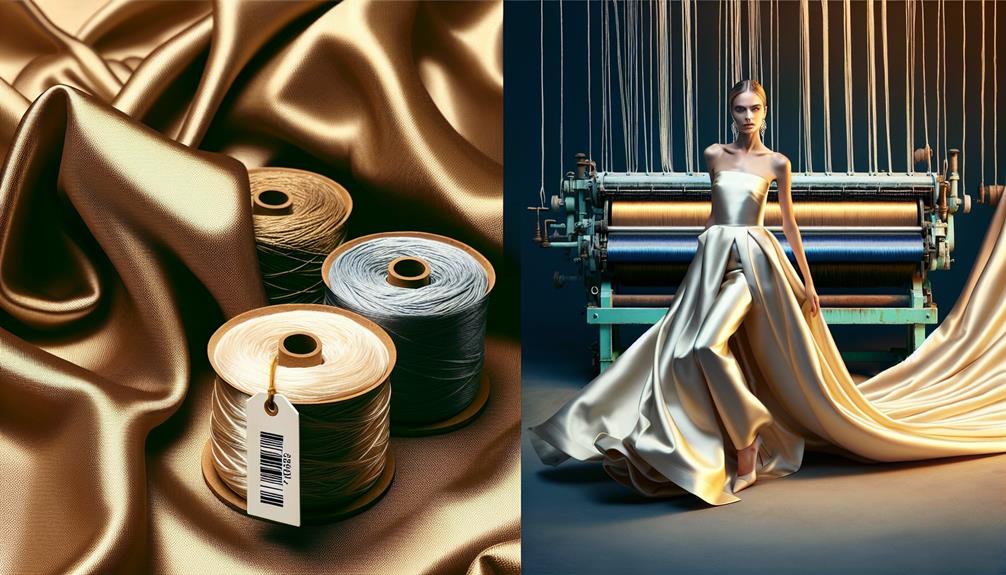Have you ever wondered why satin feels so luxurious but doesn't break the bank? I've always been fascinated by how this smooth, shiny fabric can be both high-end and affordable. It turns out, the secret lies in the use of materials like polyester, which mimics the feel of silk without the hefty price tag. Plus, with today's advanced mass production techniques, making satin has become more cost-effective than ever. But here's the kicker: while it's cheaper, there's a whole world behind its pricing that most of us don't know about. Stick around, and I'll share some intriguing insights into why satin is so budget-friendly, and we might find out if you're really getting your money's worth.
Table of Contents
Key Takeaways
- Synthetic fibers like polyester are used to make affordable satin, mimicking silk's appearance at a lower cost.
- Mass production techniques and economies of scale reduce the cost per unit, making satin cheaper.
- Automated manufacturing processes and buying materials in bulk cut down on labor and material costs.
- Competition in the textile industry drives prices down, as manufacturers aim to produce satin at the lowest possible cost.
- Cheaper satin sacrifices the premium feel of silk, balancing lower production costs with consumer affordability.
Understanding Satin's Materials
At the heart of satin's affordability lies its material composition, often crafted from synthetic fibers like polyester which are way cheaper than their natural counterparts like silk. Now, let's get this straight: silk satin is luxurious, no doubt about it. It's got that natural sheen and smoothness that's hard to beat.
But, here's the kicker – polyester satin steps in as the budget-friendly hero. It's like the understudy that's always ready to take over the lead role without missing a beat.
Polyester satin isn't just a wallet-friendly option; it's a chameleon. It mimics silk satin's look and feel so well that sometimes it's hard to tell them apart unless you're really up close and personal. I've seen it, touched it, and, honestly, sometimes it's tricky to spot the difference. The real deal-maker? Polyester satin doesn't hit your pocket as hard.
The Role of Mass Production
So, let's talk about how mass production plays a huge part in making satin so affordable.
It's all about cranking out loads of this fabric quickly and cheaply, thanks to some nifty tech and buying stuff in bulk.
This approach not only slashes costs but also keeps the supply meeting the demand, keeping prices low for all of us.
Mass Production Techniques
Mass production techniques have revolutionized how satin is made, slashing costs and boosting supply.
Let me break it down for ya. These techniques mean we're producing satin on a big scale. Think about it: when you make loads of satin items at once, everything gets cheaper – from the fabric to the final product. We're talking serious economies of scale here.
Automated machines and streamlined processes pump out satin weaves fast, cutting down on labor costs and making the whole operation more efficient. Plus, when you're buying raw materials in bulk, prices drop. It's a win-win.
Manufacturers crank out tons of satin, keep prices low, and still meet our endless craving for that smooth, shiny fabric. It's why you can snag satin without breaking the bank.
Cost Reduction Strategies
Through mass production strategies, we've seen satin prices plummet, making it super affordable for everyone. Let's dive into why that's happening.
By buying materials in bulk and sticking to standardized manufacturing, the cost to make satin fabrics takes a nosedive. It's not just about churning out more; it's how smart the process has become. Think about it: machines doing the heavy lifting, cutting down on labor costs, and the magic of streamlined supply chains. Plus, making satin overseas where it's cheaper? Genius.
And let's not forget swapping in cost-effective materials like polyester to craft that satin feel without the hefty price tag. All these cost reduction strategies mean one thing—satin's not just for the elite anymore. It's for everyone.
Supply and Demand Dynamics
Understanding the dynamics of supply and demand reveals why the mass production of satin significantly lowers its cost. When you've got heaps of satin fabric rolling out thanks to mass production, the whole game changes. It's all about making loads at once, which slashes the price per yard or meter.
This isn't just about churning out fabric; it's about doing it so efficiently that the cost per unit dives. Thanks to economies of scale, the more satin that's produced, the cheaper it gets. We're also looking at a process that's been fine-tuned to cut costs at every corner, meaning the satin that hits the shelves is way more wallet-friendly.
Plus, with so much satin out there, competition heats up, pushing prices even lower. It's a win-win for everyone hunting for affordable satin.
Quality Versus Cost
When we talk about satin, the cost often reflects the quality you're getting. If it's made from cheaper materials, like polyester, it won't hit your wallet as hard but mightn't feel as luxurious or last as long.
The price can also tell you a lot about how it's made and the brand's mark-up, influencing how we perceive its value.
Material Production Costs
Satin's affordability often boils down to the lower production costs of materials like polyester, making it a wallet-friendly option compared to silk. When diving into the specifics, polyester satin doesn't hit the wallet as hard because making it's just plain cheaper. We're talking about synthetic fibers here, which are generally less pricey than natural ones.
This difference in cost isn't just pocket change; it significantly impacts the final price tag of satin items. So, while silk screams luxury and has a price tag to match, satin offers a similar vibe without draining the bank account. It's all about those production costs. Synthetic satin materials keep things affordable, making it a go-to for folks wanting the silk feel without the silk price.
Perceived Value Impact
The perceived value of satin really takes a hit when you consider how its lower cost often means a dip in quality. You're not just getting a bargain; sometimes, you're settling for less.
Let's break it down: cheaper satin might look and feel luxe at first glance, but it's often made from lower-quality fibers like polyester, not the silk you dream of. This switch impacts everything from the fabric's durability to its softness.
Think about those satin pillowcases touted for beauty benefits—they're not all made from silk. With mass production and lower labor costs factoring in, it's no wonder satin's price can be so low. But remember, you're trading off longevity and that premium feel.
In the world of textiles, you often get what you pay for.
Design Simplicity and Costs
Simplifying designs in satin clothing significantly slashes production costs. When we dive into why satin can feel like a steal, it's clear that less is often more. From my experience, sticking to the basics not only keeps my wallet happy but also brings out the best in satin's glossy surface and durable material. Here's how simplicity impacts cost:
- Less Fabric, Less Fuss: Basic garments, like a sleek satin skirt or a smooth top, don't need much fabric. They're straightforward, with no need for the extra bells and whistles. This simplicity means manufacturers buy less material, and I'm not paying for complex, labor-intensive designs.
- Straightforward Production: Without complicated patterns or construction techniques, making a satin piece is pretty direct. The easier it's to make, the less it costs to produce. This keeps prices down, making satin an attractive option for someone like me who values both style and budget.
- Basic Finishes: Choosing simpler, cost-effective finishes over intricate details means the overall production cost stays low. This approach allows the natural beauty of the satin's glossy surface to shine, without the need for expensive add-ons.
In essence, the simplicity behind satin designs plays a huge role in keeping costs down, making it a go-to for budget-conscious fashion lovers.
Production and Labor Expenses
Understanding why satin often comes with a lower price tag, it's crucial to look at the production and labor expenses involved. Now, let's dive in.
The thing is, satin can be way cheaper than you'd expect, especially when we're talking about polyester satin. This fabric feels soft and luxurious, kind of like silk, but here's the kicker: it doesn't hit your wallet as hard. The major difference between satin made from synthetic fibers like polyester and the natural silk version is the cost of raw materials. Polyester is just cheaper to produce.
Moreover, the places where satin is made often have lower wages, which plays a big part in keeping production costs down. This doesn't just make satin more affordable; it also means that manufacturers can pump out huge quantities without breaking the bank, thanks to mass production techniques and economies of scale.
The Impact of Branding
Branding's impact on satin's pricing can't be overstated, with high-end brands often driving up costs due to their reputation and perceived quality. Let's dive into why this happens, especially with materials like cotton satin, and how brand perception plays a massive role.
First off, when you buy a satin item from a luxury brand, you're not just paying for the fabric. You're paying for the entire brand experience. Here's what I mean:
- Brand Identity: Brands spend a fortune crafting an image that resonates with luxury, quality, and exclusivity. This identity influences how we perceive their cotton satin products, making us willing to pay a premium.
- Marketing Efforts: The more a brand markets itself as a luxury icon, the more desirable their products become. This desirability directly impacts the pricing, especially with items made of materials like cotton satin.
- Exclusivity: Luxury brands often limit the availability of their products, creating a sense of scarcity. This scarcity, combined with a strong brand perception, can significantly inflate the price of satin items.
Alternatives to Expensive Satin
Looking for luxury without the hefty price tag? Polyester satin offers an affordable yet chic alternative to silk satin. Now, don't get me wrong, I love the feel of natural fabric against my skin as much as the next person. But when the budget's tight, I'm all for finding fabrics that look similar to silk satin without draining my wallet.
Here's a quick breakdown of some options:
| Material | Cost-Effectiveness | Feel |
|---|---|---|
| Polyester Satin | High | Smooth, less breathable |
| Cotton Satin | Moderate | Softer, more breathable |
| Synthetic Blends | Variable | Mix of qualities |
| Vintage Satin | Depends on find | Unique, potentially luxurious |
Cotton satin's another go-to for me. It's got a different texture, sure, but it's still pretty luxurious. And those synthetic satin blends? They're like the best of both worlds. Plus, hunting through sales or second-hand shops for satin pieces can be like treasure hunting for luxe looks on a budget. It's all about keeping an eye out and knowing your alternatives.
Frequently Asked Questions
Why Does Satin Look so Cheap?
I've noticed satin looks cheap because it's often made of polyester, a synthetic material. It lacks silk's natural luxury and feels less authentic. The manufacturing process is cheaper, making polyester satin affordable but less appealing.
Is Satin Considered Cheap?
I've noticed satin's often labeled as cheap because it's mainly made from synthetic materials like polyester. This makes it more affordable than natural fibers, but it still offers a luxurious feel at a lower price.
What Are the Disadvantages of Satin?
I've noticed satin's downsides include its tendency to feel plasticky, lack of breathability, and it's prone to snagging or pilling. It doesn't have silk's luxurious sheen or drape, making it less appealing overall.
Is Satin a Good Quality?
I think satin's quality really depends on what you're after. High-quality satin, like silk, feels luxurious and lasts longer. But, if you're budget-conscious, polyester satin's cheaper and still looks pretty good, just not as durable.
- Why Is Red Velvet Not Red? - April 25, 2024
- How Do You Describe Velvet Fabric? - April 25, 2024
- How Strong Is Velvet? - April 25, 2024








